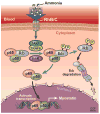Sarcopenia from mechanism to diagnosis and treatment in liver disease
- PMID: 27515775
- PMCID: PMC5116259
- DOI: 10.1016/j.jhep.2016.07.040
Sarcopenia from mechanism to diagnosis and treatment in liver disease
Abstract
Sarcopenia or loss of skeletal muscle mass is the major component of malnutrition and is a frequent complication in cirrhosis that adversely affects clinical outcomes. These include survival, quality of life, development of other complications and post liver transplantation survival. Radiological image analysis is currently utilized to diagnose sarcopenia in cirrhosis. Nutrient supplementation and physical activity are used to counter sarcopenia but have not been consistently effective because the underlying molecular and metabolic abnormalities persist or are not influenced by these treatments. Even though alterations in food intake, hypermetabolism, alterations in amino acid profiles, endotoxemia, accelerated starvation and decreased mobility may all contribute to sarcopenia in cirrhosis, hyperammonemia has recently gained attention as a possible mediator of the liver-muscle axis. Increased muscle ammonia causes: cataplerosis of α-ketoglutarate, increased transport of leucine in exchange for glutamine, impaired signaling by leucine, increased expression of myostatin (a transforming growth factor beta superfamily member) and an increased phosphorylation of eukaryotic initiation factor 2α. In addition, mitochondrial dysfunction, increased reactive oxygen species that decrease protein synthesis and increased autophagy mediated proteolysis, also play a role. These molecular and metabolic alterations may contribute to the anabolic resistance and inadequate response to nutrient supplementation in cirrhosis. Central and skeletal muscle fatigue contributes to impaired exercise capacity and responses. Use of proteins with low ammoniagenic potential, leucine enriched amino acid supplementation, long-term ammonia lowering strategies and a combination of resistance and endurance exercise to increase muscle mass and function may target the molecular abnormalities in the muscle. Strategies targeting endotoxemia and the gut microbiome need further evaluation.
Keywords: Clinical outcomes; Hyperammonemia; Leucine; Myostatin; Sarcopenia; mTORC1.
Copyright © 2016 European Association for the Study of the Liver. Published by Elsevier B.V. All rights reserved.
Figures



Comment in
-
Myokines: A promising therapeutic target for hepatic encephalopathy.J Hepatol. 2017 May;66(5):1099-1100. doi: 10.1016/j.jhep.2016.10.040. Epub 2017 Feb 3. J Hepatol. 2017. PMID: 28167320 No abstract available.
-
Reply to: "Myokines: a promising therapeutic target for hepatic encephalopathy".J Hepatol. 2017 May;66(5):1100-1101. doi: 10.1016/j.jhep.2017.01.023. Epub 2017 Feb 6. J Hepatol. 2017. PMID: 28185843 No abstract available.
References
-
- Alberino F, Gatta A, Amodio P, Merkel C, Di Pascoli L, Boffo G, et al. Nutrition and survival in patients with liver cirrhosis. Nutrition. 2001;17:445–450. - PubMed
-
- Merli M, Romiti A, Riggio O, Capocaccia L. Optimal nutritional indexes in chronic liver disease. JPEN J Parenter Enteral Nutr. 1987;11:130S–134S. - PubMed
-
- Merli M, Riggio O, Dally L. Does malnutrition affect survival in cirrhosis? PINC (Policentrica Italiana Nutrizione Cirrosi) Hepatology. 1996;23:1041–1046. - PubMed
-
- Giusto M, Lattanzi B, Albanese C, Galtieri A, Farcomeni A, Giannelli V, et al. Sarcopenia in liver cirrhosis: the role of computed tomography scan for the assessment of muscle mass compared with dual-energy X-ray absorptiometry and anthropometry. Eur J Gastroenterol Hepatol. 2015;27:328–334. - PubMed
Publication types
MeSH terms
Substances
Grants and funding
LinkOut - more resources
Full Text Sources
Other Literature Sources
Medical

